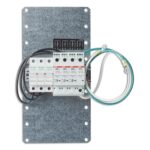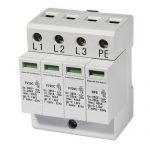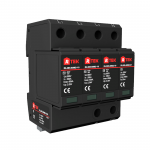Surge Protector
Need Of Surge Protector
Surge protector, also known as a spike suppressor, surge suppressor, surge diverter, surge protection device (SPD), or transient voltage surge suppressor (TVSS), is is an appliance or device designed to safeguard electrical equipment from voltage spikes in alternating current (AC) circuits. The purpose of surge protection devices (SPDs) is to lessen the harm that surges can do to electrical and electronic equipment. Depending on the technology they contain and how they function against transient overvoltages, there are various varieties of SPDs.
Surge protectors are advised for usage in both households and businesses. There are two different types of surge protectors. This covers both an outlet or strip surge protector and a whole-house or building surge protector. In contrast to an outlet or strip surge protector, which just shields the devices plugged into the surge-protected outlet or strip, a whole home or building surge protector protects the entire building or home.

When To Use Surge Protector
- With your PC, a surge protector is recommended. It contains several voltage-sensitive parts that a power surge might easily harm. This damage could ruin your system or, at the least, limit the lifespan of your computer. It also has the potential to erase all of your data.
- Surge protectors are an excellent idea for other high-end electronic devices such as entertainment center components. Although a surge protector will typically increase the lifespan of these gadgets, there is always a danger that a significant power surge can seriously harm them.
- It’s preferable to avoid plugging equipment into a surge protector that naturally draws a lot of amperage because doing so can result in the protector wearing out too quickly. These include appliances like coffee makers, space heaters, refrigerators, and vacuum cleaners that have heating elements or powerful electric motors. These devices need to be directly plugged into a wall socket.
- Avoid connecting multiple power strips in a chain because this may result in improper voltage output, excessive heat, or even fire.
Types and Working Of Surge Protector Devices
There are three different types of Surge Protective Devices:
Type 1 SPD installed at the origin
e.g. main distribution board.

Type 2 SPD installed at sub-distribution boards
(Combined Type 1 & 2 SPDs are available and are usually installed in consumer units).

Type 3 SPD installed close to the protected load.
They must only be installed as a supplement to Type 2 SPD.

The surge-protective components, mechanical design, and connection to the electrical distribution network all play a role in an SPD’s capacity to reduce overvoltages on the electrical distribution network by redirecting surge currents. An SPD is designed to either divert surge current or minimize transient overvoltages. There is at least one nonlinear element in it. In the simplest terms, SPDs aim to avoid equipment damage and downtime caused by transient voltage surges reaching the devices they safeguard by limiting transient overvoltages.
Important Specifications To Be Noted Before Selecting Surge Protectors
These are some of the most widely stated requirements for surge protectors for AC mains and some applications involving the protection of data communications.
- Clamping Voltage-Better protection is indicated by a lower clamping voltage, although this can occasionally mean a shorter lifespan for the entire protective system. The stated standard rating’s three lowest levels of protection are 330 V, 400 V, and 500 V. For devices using 120 V AC, the typical let-through voltage is 330 volts.
- According to its Joule rating, a MOV-based surge protector is capable of theoretically absorbing a certain amount of energy in a single incident without malfunctioning. Better shields have ratings higher than 1,000 joules and 40,000 amps.
- Response Time-Surge protectors don’t work instantly; there is a little delay of a few nanoseconds. The linked equipment may be subject to a portion of the surge due to slower response times and system impedance.
- Standards-Some frequently listed standards include IEC 61641-11,21,22 series respectively.Each standard defines various protector characteristics, test vectors, or operational purpose.
Why Choose LPES For Surge Protection Device (SPD) ?
LPES offers comprehensive Surge Protection Services, from design to installation, in accordance with NBC 2016 and the most recent IS/IEC 622305. The design and service team at LPES is extremely skilled and has a wealth of expertise working on a variety of projects, such as high-rise hotels and hospitals, airports and tunnels, commercial buildings, metro stations, refineries, and others.
Please feel free to contact us if you would want further details on how to secure your family, your house, or your building society. Our LPES team consists of dedicated service professionals equipped with all smart technologies who are always ready to help and they are adept in the use of Surge Protection design and services that incorporate the highly advanced and reliable and reasonable Surge Protection system to provide the most attractive and practical services .
